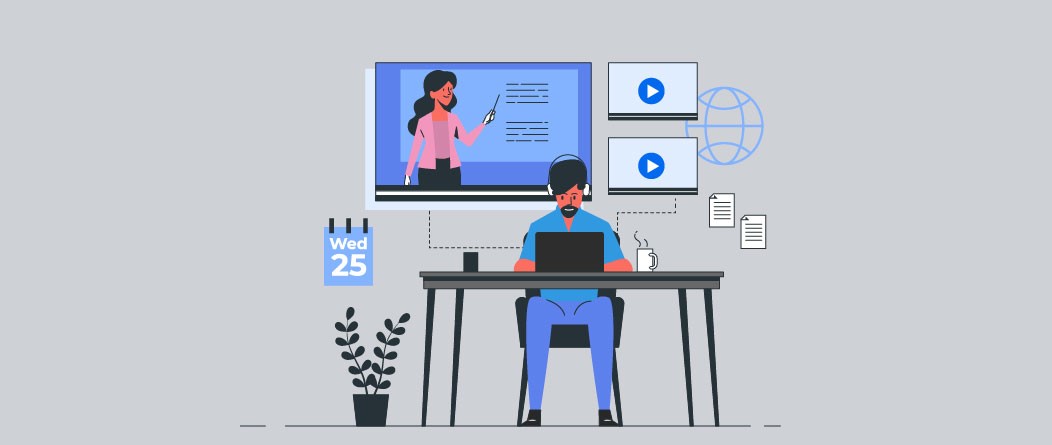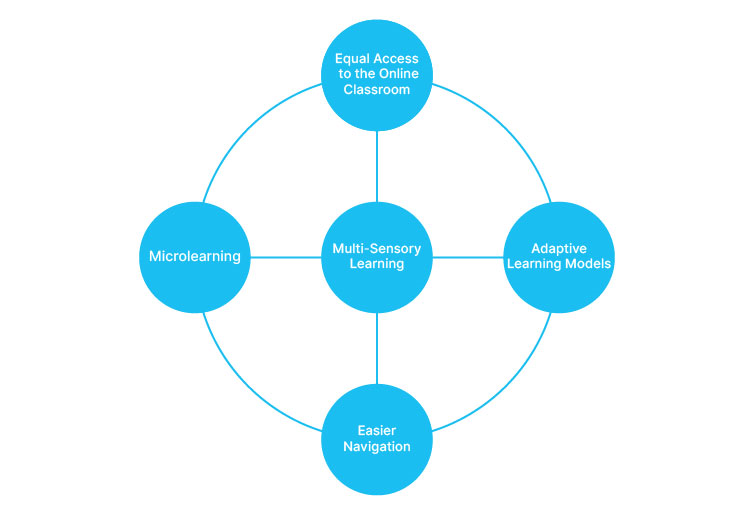Studies show that 70% of students agree online courses are just as good or better than in-person classes.
26% of students even claimed to learn better online.
One obvious reason for this is the added flexibility of learning remotely. You can learn at your own pace without being rushed. You don’t have to “follow” the teacher – you can take breaks to recharge your focus. If you feel you can’t continue at some point, you can simply rewind and rewatch recorded lectures to catch up.
But while we consider the pros and cons of online learning for the average college student, educational institutions must also look into support for students with learning disabilities. Online learning for students with learning disabilities is not without its challenges. However, online learning platforms like SimpliTaught can help make online learning more inclusive for students with different backgrounds, aptitudes, and learning patterns. We do this by solving the mismatch between learning and teaching styles.
This blog focuses on how to help students with learning disabilities in the classroom through EdTech and remote learning platforms.
Strategies for Online Learning for Students with Learning Disabilities
Here are some of the ways you can provide support for students with learning disabilities in online learning environments:
Equal Access to Online Classrooms
Accessibility is the biggest challenge for students with learning disabilities, so we must find ways to make education more inclusive and accessible. eLearning platforms for students provide study materials to support student learning using disability-friendly fonts and colors. Also, the online learning environment automatically eliminates barriers like sound disruption, lighting issues, etc. This increases access to the classroom for students with learning disabilities. Students also have instant access to educators, which means they can always reach out with their questions and get answers. The chapter-driven chat rooms for textbooks ensure these students can participate in classroom discussions without feeling anxious or overwhelmed, further enhancing accessibility.
Adaptive Learning Models
Students with learning disabilities struggle to keep up with their peers because they don’t learn the same way as them. Most teaching pedagogies demand abstract thinking to help solidify concepts and make connections between theory and the real world. Unfortunately, students with hidden disabilities may not have the cognitive skills to do that. Abstract thinking can be complicated because they may have difficulty with abstract reasoning, understanding connections between concepts, cause-and-effect situations, and interpreting verbal information. Also, they usually don’t do well with metaphors and analogies because they often take these things literally rather than figuratively. This means they have unique learning needs – which is okay! Studies show that a typical classroom has students with various learning styles, especially since most students don’t fall within a single learning category – we’ll call them multimodal learners.
Multimodal means these students learn best when they use a combination of learning styles rather than just one, and this combination will generally be different for individual students. So, each student in a classroom will have unique academic needs, and that includes students with learning disabilities. In order to help students with diverse learning backgrounds, the best online learning platforms (Hint: SimpliTaught) adopt adaptive learning strategies to ensure every student gets the support they need to study. Adaptive learning is also a great support for students with learning disabilities because it can cater to their unique needs. At SimpliTaught, we adopt an artificial intelligence and machine learning-based model to personalize study materials according to every student’s aptitude and learning preferences. This guarantees each student gets the right learning resources – meaning they can focus on how they learn best and make the most of their study time. Online learning for students with learning disabilities must definitely incorporate adaptive learning.
Easier Navigation
Schools that want to know how to help students with learning disabilities in the classroom should facilitate learning that is easier to navigate. Virtual tools and classrooms should be simple enough that students will not need training to use them. Still, if training is required, educational institutions should actively provide this training to students. Besides this, they should adopt user-friendly online learning solutions to make virtual classrooms more accessible for students with learning disabilities. A great example can be using the right colors in eLearning courses to help students learn better without getting distracted because distractions are a significant pain point for students with learning disabilities.
Microlearning
Microlearning means breaking down difficult concepts into smaller chunks that students can easily understand. Since college students with learning disabilities often struggle with making connections between ideas and grasping new concepts, microlearning is ideal for helping them learn faster. SimpliTaught is one example of online learning for students that combines flexibility and self-accountability alongside microlearning strategies to help students study faster and smarter!
Multi-Sensory Learning
Multisensory learning is excellent support for students with learning disabilities because it allows them to learn according to their strengths and weaknesses. Studies show students with learning disabilities have “hidden strengths” like creative problem-solving, visual-spatial thinking, and identifying patterns. This means they can make up for their relatively weak cognitive skills by relying on these strengths. At SimpliTaught, we use AI to provide multisensory learning materials like diagrams, podcasts, articles, videos, etc., based on textbook concepts, meaning students with learning disabilities can also learn according to their unique learning preferences.
SimpliTaught Provides Personalized Support for Students with Learning Disabilities
SimpliTaught is an eLearning platform for students. We use artificial intelligence and machine learning to help students learn according to their preferred learning styles. Our AI gathers comprehensive study materials from all over the internet, like videos, podcasts, articles, etc., in order to help college students understand their textbooks. We also break down difficult concepts into smaller chunks that students can easily understand. Besides this, our ML model observes how students interact with the study materials to record their unique learning behaviors. This information helps us personalize study materials to ensure adaptive academic support for all students, including students with learning disabilities. So, we minimize challenges in online learning for students with learning disabilities.
Discover how SimpliTaught can support students with learning disabilities at your school to make the most of online education platforms and graduate successfully. Contact us at info@SimpliTaught.com.



